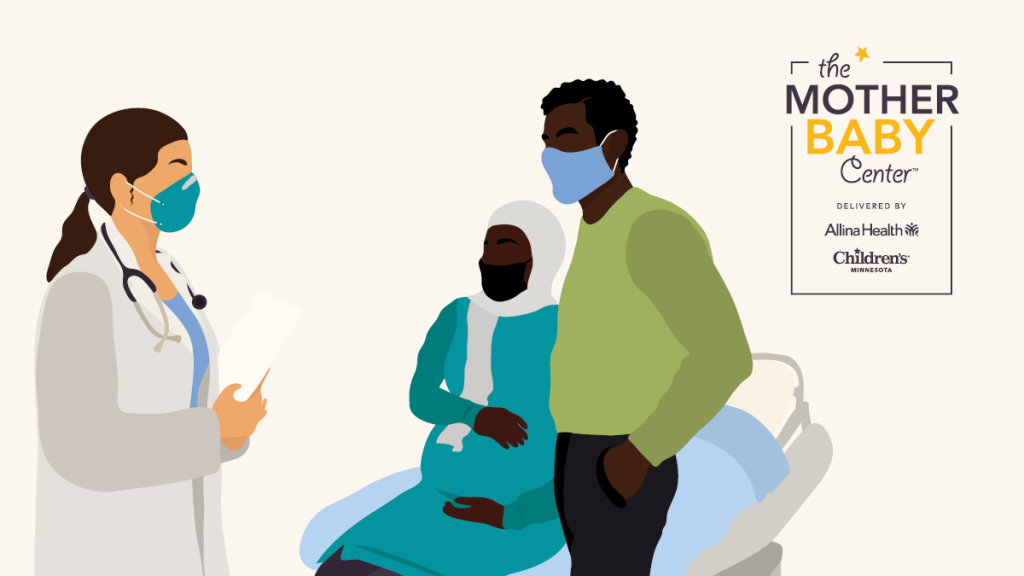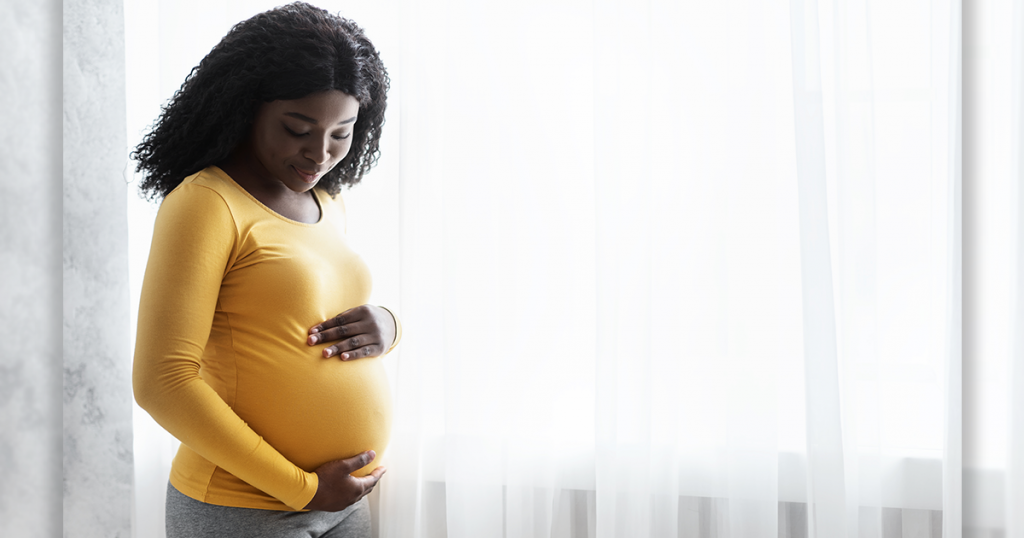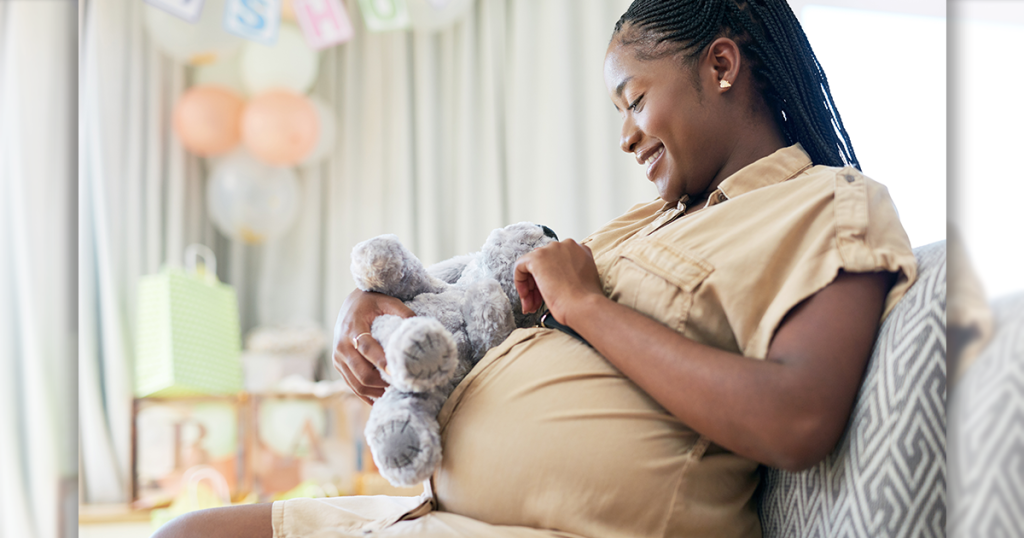
Hooray, you made it to the third trimester! Like most expectant mothers and partners, you’re likely feeling a wide range of emotions about welcoming your baby soon – excited, nervous, impatient, scared – or most likely, a swirling combination of all of the above. Your baby continues to grow, so your belly continues to grow, and other parts of your body are changing, too.
There are some important things to do in your third trimester – so we created a third trimester timeline and checklist for you here. (Because “pregnancy brain” is a real thing, and we really want you to feel prepared!)
The third trimester is the time to get organized for the birth of your baby. It’s important to know how to monitor your baby’s movements and understand signs of early labor just in case. Making plans for your labor and delivery, finishing up the nursery, and getting the infant car seat installed correctly are just a few of the things on your third trimester to-do list.
Explore our blog for more great tips and advice for new and expecting parents.
You’ve made it to the third trimester! Now what?
The third trimester starts at week 28 of pregnancy and lasts until you give birth around week 40. It’s months 7-9 of your pregnancy – the home stretch! Chances are you’re finding it harder to move around and tie your shoes. Taking deep breaths can even be a challenge as your baby continues to grow and crowd your organs. And can you believe how often you need to use the bathroom?
If this is your first pregnancy, you might be wondering how you will know when labor has started. You’ll start seeing your health care provider every other week from 28-36 weeks, then every week until you deliver. So you’ll have lots of chances to ask your questions and make sure you and your baby are doing well.
The third trimester can be wonderful for many expectant mothers. It’s a special time to savor activities with your friends and family before your routine changes. Preparing the baby’s spaces in your home (commonly called “nesting”), packing your hospital bag, and reading about caring for an infant can make many mothers feel more settled and prepared, especially during the last month of pregnancy.

Third trimester to-do list: 11 things to prepare
It might feel like there are a million things to do in the third trimester, but try not to get overwhelmed and lean on others to help you. Rest and keeping your stress level in check are really important right now. Here are some of the most important dos and don’ts in third trimester of pregnancy to add to your last 10 weeks of pregnancy checklist.
Track your baby’s movements
Many women say their favorite thing to do in the third trimester is watch their belly when their baby is active. Sometimes you can even see the shape of a little foot pushing against your insides!
Fetal kick counts or movements aren’t just fun to experience, they’re also important for monitoring the health of your baby. By familiarizing yourself with your baby’s patterns, you could sense if something is off and tell your health care provider so they can intervene.
Monitoring your baby’s movements might require some concentration and practice. In general, you’re trying to determine how long it takes your baby to move ten times, which should take about two hours or less. This includes kicks, rolls, flutters, jabs, etc.
- Try to do kick counts at least once a day and at roughly the same time of day.
- You might find your baby is most active after you eat, go for a walk, and in the evening.
- You can do the counts in any position, but laying on your left side increases blood flow and might help get your baby moving.
- Keep a list of your daily kick counts and any notes like time of day, type of movements, and activity you did to spur the movements, etc.
- If you haven’t counted ten movements after two hours of trying, call your health care provider. Chances are if you’ve had a healthy pregnancy so far, your baby is fine. But your doctor might want to see you and monitor your baby just to be safe.
- During the last month of your pregnancy, your baby’s movements shouldn’t decrease, but they will probably feel different because your baby has a lot less space to kick.
- Getting familiar with your baby’s movements is also a great way to begin the bonding process.
Enjoy your baby shower (and don’t forget to write thank yous!)
Celebrating the pending arrival of a new baby is a wonderful tradition that many pregnant women experience. A baby shower is usually hosted by family members or friends to “shower” the mother and father/partner with baby supplies. Typically, a baby shower happens 4 to 6 weeks before the baby’s due date, but it can happen anytime, even after the baby arrives.
If you’re having a baby shower, the host will likely encourage you to create a baby registry at your favorite baby supply stores. Then your guests will know exactly which items you’re hoping to receive. Tip: Ask experienced parents about their favorite baby items! After your baby shower, make sure to write thank you notes to everyone who gave you a gift. Add this task to your third trimester to do list – you’ll be glad to get thank you notes done before your baby arrives!
Consider More Classes!
As the saying goes: knowledge is power! Learning more about labor and delivery, caring for an infant, postpartum recovery, and a range of other topics can help ease your anxiety and is a great idea for your getting ready for baby checklist.
- If you haven’t already, take a birth class. You’ll learn about the signs of labor, types of pain management, how the labor and delivery will progress, emergency interventions that might be needed, and newborn care.
- Many expecting parents (and caregivers) take an infant CPR and first aid class. There are in-person and online options.
- Classes (in-person or virtual) and books about breastfeeding, baby sleep, developmental milestones, baby care, etc. can be helpful and empowering.
- You can find more resources and pre-register for your stay at The Mother Baby Center website. You can even watch a virtual tour of The Mother Baby Center location where you’ll be delivering!
Decide how you’ll cope with labor pain
You’ve probably heard this dozens of times during your pregnancy: every woman’s pregnancy, labor, and delivery are different. It’s true! There are definitely some things that are typical for most women, but some choices are yours to make, especially on how to prepare for labor in third trimester. Every woman’s experience with pain is different, and you have choices about pain medications. It’s important to consider your options while you prepare your body for labor in the third trimester.
- Pain medications during childbirth include: epidural block, spinal block, opioids, local anesthetic injection, and nitrous oxide. They offer various levels of pain relief and are considered safe for you and your baby. It is recommended to work with your health care team to make the best decision for you and your baby.
- An unmedicated vaginal delivery (or “natural” birth) is most successful when a mother has prepared mentally and physically ahead of time for the experience. There are birth classes designed specifically for this choice.
- Consider hiring a professional labor coach or doula to assist you during your labor and delivery. Your health care team at your hospital or delivery center will support you during this time, but some women prefer to have the additional support.
Learn the Stages of Labor
While you’re researching how to prepare for labor in the third semester, make sure to add learning the stages of labor to your list. Weeks before your first contractions begin, your health care provider will give you a clear set of guidelines for when to call and head to the hospital or birth center. Knowing what to expect during your labor and delivery can help ease your mind and give you another chance to prepare.
The three stages of labor and delivery are:
- First stage: Contractions begin. Your cervix begins to efface (thins out) and dilate (open). Contractions will gradually get stronger, longer, and closer together. This is the longest stage of labor, especially if this is your first birth.
- Second stage: Pushing. Once your cervix is fully dilated (10 cm), your contractions might become more spaced out and less intense. You will likely feel the urge to push as your uterus contracts and moves your baby down the birth canal until they’re out.
- Third stage: Delivering the placenta. Minutes after your baby is born, your uterus begins to contract again. The placenta separates from your uterus, and with one short push, it will be out. This isn’t difficult or painful, and your health care provider will guide you.
Create your birth plan
With all of the things to do in your third trimester of pregnancy, make sure to give some thought to your preferences for your labor and delivery experience. Many expectant mothers write (or fill out) a birth plan to communicate their goals and preferences before, during, and after labor and delivery. It’s your chance to describe your “best case scenario” for your health care providers to follow if everything goes according to the plan.
- There’s no right or wrong way to write a birth plan. You can outline your own notes or use a template birth plan offered by your hospital, birth center, or one found online.
- Consider your options for pain management, labor activities/assistance, medications, interventions, delivery room environment, people in the room, what happens after the birth, etc.
- Talk to your health care provider about your birth plan – and be open to feedback. It’s important to make sure you’re both on the same page for the well-being of you and your baby.
- You do not need to make a birth plan. If writing a plan makes you anxious or you’re concerned about being disappointed if it doesn’t get followed, know your health care provider will still provide excellent care for you and your baby without one.
Remember, a birth plan outlines your preferences for the “best case scenario.” If medical interventions are necessary for the safety of you or your baby, your birth plan might not be followed. And that’s okay because you will want your health care team to provide their expert care as needed.
Pack your hospital bag
When you’ve reached the last month of pregnancy, you should start to think about what you’ll bring to the hospital when the main event begins. There are things you’ll need and other things you’ll be glad to have along. Packing your bag ahead of time is a good way to feel prepared.
On average, a woman stays in the hospital for 1-2 days after delivering their baby vaginally. If you deliver via cesarean (C-section), you’ll likely be there for 3-4 days. Consider how many people will be going to – and leaving – the hospital, so you’re sure to have everyone covered.
Packing list for mom
- Photo ID, insurance info, hospital forms, and birth plan (if you have one). You can pre-register online at The Mother Baby Center website.
- Daily prescription medication
- Eyeglasses
- Cell phone and charger
- Warm, non-skid socks (2-3 pairs)
- Robe, loose-fitting shirt or tank top to wear when you deliver (it might be sacrificed to the cause)
- Lip balm, headband, ponytail holders
- Favorite snacks and beverages, hard candy, lozenges
- Maternity bras (2) and nursing pads (several), even if you don’t plan to nurse. You’ll be glad for the support and leak protection.
- Maternity or period underwear. The hospital will provide disposable underwear and pads, but some women find them uncomfortable. If you’re preparing for a C-section, consider low-rise postpartum underwear that sits below the incision.
- Toiletries and personal items – hairbrush, toothbrush, toothpaste, deodorant, face wash, shampoo, conditioner, lotion, contact lenses case and solution, makeup, and hairdryer.
- Loose, lightweight clothing in six-month maternity size. Flat, comfortable shoes to wear home.
- Light reading materials, magazines
- Earbuds to listen to music on your phone
- Favorite pillow (optional)
Packing list for baby
- Infant car seat. This baby gear must be correctly installed!
- Coming home outfit and hat. Bring a few options in different sizes.
- Warm blankets for the ride home.
Packing list for partner
- Cell phone and charger
- Change(s) of clothes
- Toiletries
- Snacks
- Entertainment: Something to read, listen to, or watch
- Camera, batteries, charger, extra memory card
- Daily prescription medication
- Cash or change for vending machines, parking (you can confirm this ahead of time)
Don’t forget: Figure out how you’re getting to the hospital or birth center! Who will watch the other kids and/or pets when you’re gone? Make your plans now to feel more prepared when the big day arrives.
Finish the nursery
It can be so fun to design the baby’s nursery. Baby boutiques and mommy blogs are full of amazing ideas to make your baby’s space adorable and unique. But in reality, babies don’t really need a fancy space to be comfortable and safe. So, try not to get overwhelmed with preparing the nursery and focus on the essentials as you approach your last month of pregnancy.
Here’s a list of the most essential nursery items:
- Crib or bassinet. Check the U.S. Consumer Product Safety Commission website for safety tips and recalls.
- Firm, flat mattress that fits snugly in the crib (less than two fingers should fit between mattress and crib)
- Washable crib mattress pads (2-3)
- Fitted crib sheets (4-5)
- Music player, Bluetooth speaker, white noise machine
- Rocking chair or armchair for feeding and snuggling
- Lamp with a dimmer
- Nightlight
- Changing table. If your dresser is low, you can secure a changing pad on top of it.
- Diaper pail
- Clothing storage, dresser
- Bookshelf
- Baskets and bins for toys, diapers and supplies
- Crib mobile (to use until your baby can reach it)
- Baby swing or bouncer
- Play mat or easy-to-clean rug
- Baby toys, board books
- Baby monitor
Preparing baby clothes is a whole other category and depends on several factors – the size of baby when born, season, access to diaper for frequent changes, comfort… and the list goes on! In general, it’s helpful to have a variety of options in a range of sizes at the start, then buy more of your favorite things when everyone gets settled. Just make sure it’s all washable!
Narrow down baby names
Another helpful thing to do during the third trimester is to decide on a short list of potential baby names. This can be tricky, especially if you and your partner don’t agree. Some tips for finding some great contenders are:
- Look at your family tree. Family names can honor a loved one or carry on a special tradition.
- Think about nicknames. Do you also like the shortened version of a name you’re considering?
- Remember to check the initials. Some letters make better combinations than others.
- Look up the meaning of names.
- Avoid trendy names.
- Try not to feel pressured by other family members.
- Middle names can offer a compromise option.
- Say the name out loud. See what it looks like written down.
If you and your partner just cannot agree on a name, try this: each of you write a list of 10 names you like. Trade lists, then take turns crossing out one name on the other’s list that you don’t love. Keep taking turns until you have a small list of names you can both live with.
Read up on baby care
Learning how to care for a newborn is a great activity to add to your third trimester to do list. Switch gears now to books about newborn routines, breastfeeding, sleep training, developmental markers, and other things you’ll be doing in the coming weeks and months ahead. You might not have much time to read after your baby is born, so prepare yourself now.
- Birth classes offer some newborn care education, so definitely check into those if you haven’t already.
- Consider joining a “mommy/daddy and me group.” New parents experiencing many of the same things can be a terrific resource for each other.
- Talk to experienced moms and dads you know for tips and tricks to survive the first few days and weeks after you bring home your baby. They are the true experts!
Talk to your baby
Did you know your baby can hear you now? Between 16- 22 weeks, a fetus can hear their mother’s breathing and heartbeat. After 23 weeks, they can hear sounds from outside the womb, with the mother’s voice being the clearest. At around 26 weeks, your baby might start to respond to certain sounds. A loud noise might startle the baby and cause them to move. Music might soothe them.
Talking to your baby in utero is a great way to start the bonding process during the third trimester of your pregnancy. Even reading a book or magazine aloud starts the development of language skills.
Find a pediatrician for your newborn baby at The Mother Baby Center.

Common third trimester experiences
Many women describe their third trimester body as feeling like a passenger in a strange, hard-to-recognize vessel. Your body has undergone so many changes in the past 7 months, and the third trimester brings even more big changes and strange sensations. Even if someone creates a third trimester checklist by week, everything can change at any point by the time you’re at full term.
Your baby is packing on the pounds now. By week 31, your baby has finished most of their major fetal development and is gaining weight more quickly. By week 36, your baby gains about a half pound and grows a half inch each week, so it’s no surprise your organs are feeling squished!
Most pregnant women say they feel clumsy and have difficulty picking things up or putting on their shoes, especially during the last month of pregnancy. You might notice stretch marks appear on your breasts, belly, and thighs. Leg cramps and swelling are also common during your third trimester.
Some serious pregnancy complications like preeclampsia or premature labor can happen during the third trimester, so seeing your health care provider regularly is a must. Taking excellent care of yourself now is your biggest priority for you and your baby.
Headaches
Mild headaches during pregnancy are normal. Hormones, stress, and lack of sleep are all common triggers for headaches during pregnancy. However, if you have a severe headache during your third trimester, call your health care provider right away, as it could be a sign of preeclampsia, a serious blood pressure disorder caused by abnormal blood flow within the placenta.
Swelling
Sorry to say, but swelling in the third trimester is also normal. Moderate swelling in your ankles, feet, and hands happens because you’re retaining more water. Watch for sudden or excessive swelling anywhere, including your face and around your eyes, because this could be another sign of preeclampsia. Contact your health care provider right away if this happens.
Fatigue
Your body is working overtime, so it’s no surprise if you’re tired. Some women sail through their third trimester with lots of energy, but plenty of others feel their energy levels take a dive. You’re carrying extra weight, breathing harder and being short of breath, and likely not sleeping great. Focus on resting whenever you can – that third trimester to do list can wait!
Pelvic and back pain
During the third trimester, your ligaments loosen and stretch to support your growing uterus. Also, your baby’s head will start to move lower in your pelvis, putting pressure on your cervix and the nerves around your uterus. All of these changes can cause pain in your pelvis and back. Sometimes the pain is shooting and sudden, and the lower back pain might be constant.
Light exercises such as stretching, swimming, walking, and pelvic tilts might offer some relief. Call your healthcare provider right away if the pain is severe or you have other symptoms like a fever or vaginal bleeding.
Braxton Hicks contractions
As if there weren’t enough things to keep track of during your third trimester, how about experiencing some “false” labor pains that mimic contractions? They’re called Braxton Hicks contractions, and they can start any time during your pregnancy, although they’re most likely to be felt as you near your due date. Some women never feel them.
Typical Braxton Hicks contractions are infrequent and have no pattern, vary in intensity but are usually not painful, can feel like mild menstrual cramps, and might stop when you move or change position. If you experience severe pain or other concerning symptoms, call your health care provider right away.
What to know about sex in the third trimester
In most cases, sex is safe during the third trimester of pregnancy. If you’re having a healthy and uncomplicated pregnancy, you can probably have sex right up until you go into labor. Having sex won’t hurt your baby because they are protected by your uterus and a layer of muscles and safely cushioned by the amniotic fluid.
Sex drive is different for every pregnant woman since it depends on how you’re feeling physically and emotionally – which changes a lot during pregnancy!
Your health care provider might advise against sex in the third trimester if you have placenta previa, vaginal bleeding, preterm labor, or cervical insufficiency. As always, talk to your health care provider about what’s best for you and your baby.
Learn more about creating a birth plan that fits your needs.

Deliver your baby at The Mother Baby Center
The third trimester is a wonderful and sometimes challenging time while you make final preparations to meet your beautiful baby. Try to enjoy this special time, get rest, and take excellent care of yourself. And ask for help! Your friends and family can make a terrific support group now and after your baby arrives.
As you continue to prepare, check out the other helpful articles about pregnancy and birth on our blog. We look forward to helping you welcome your baby and care for you both during your labor and delivery at The Mother Baby Center.